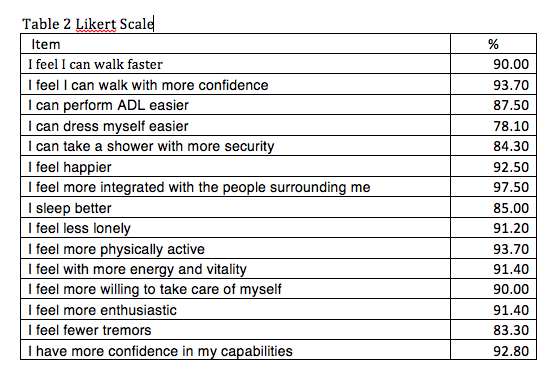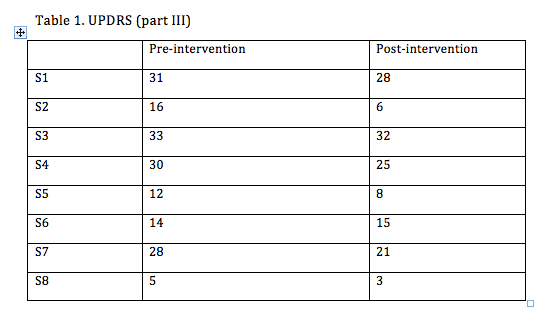Session Information
Date: Thursday, June 8, 2017
Session Title: Parkinson’s Disease: Clinical Trials, Pharmacology And Treatment
Session Time: 1:15pm-2:45pm
Location: Exhibit Hall C
Objective: To evaluate changes in motor symptoms and quality of life for people with Parkinson’s disease (PD) as a result of an intensive short-term dance intervention.
Background: Physical activity and exercise based rehabilitation programs, which aim at improving motor symptoms such as balance, strength and range of motion as well as non-motor symptoms, are commonly recommended to people with PD. Studies consisting of weekly and biweekly intervention propose that dance can be a feasible form of rehabilitation with the additional benefit of a reduced dropout rate due to its highly enjoyable and social nature. However, few of the aforementioned studies have examined the relationship between benefits and dosage. In order to attain the largest effect from dance on patients affected by PD, daily intervention may be crucial. Consequently, our aim was to examine the effect of daily participation of this population in Argentine tango classes.
Methods: Eight people with mild and moderate severity (Hoehn & Yahr scale I-II) idiopathic Parkinson disease participated in a study consisting of ten 90’ dance classes within a period of 2 weeks. Two tango instructors taught the classes. Participants were partnered with volunteers who had previous experience in tango dancing. Motor symptoms were evaluated using the MDS-UPDRS part III before and after the training session. A 12 question Likert scale and personal interviews with PD patients were used to evaluate the effects on quality of life following the training session.
Results: Our study found improvements in motor behaviour as measured by the UPDRS (p<0.05, n=8), as well as positive outcomes in Likert scales showing improvements in perceived managing of activities of daily living (ADL), quality of sleep, and psychological basic needs such as relatedness, autonomy and competence. An augmented sense of vitality was also reported by participants.
[Table 1]
[Table 2]
Conclusions: Participation in a two week daily dance classes intervention shows significant improvements in motor symptoms and quality of life of people with PD. The dosage of dance intervention needs further study and consideration in order to help participants obtain the best possible results from this form of rehabilitation.
To cite this abstract in AMA style:
D. Rabinovich, J. DeSouza, T. Arakaki, S. Rodriguez Quiroga, V. Litvak, J. Firmani, N. Garreto. Intensive Short-Term Dance Intervention in Parkinson’s Disease [abstract]. Mov Disord. 2017; 32 (suppl 2). https://www.mdsabstracts.org/abstract/intensive-short-term-dance-intervention-in-parkinsons-disease/. Accessed December 27, 2025.« Back to 2017 International Congress
MDS Abstracts - https://www.mdsabstracts.org/abstract/intensive-short-term-dance-intervention-in-parkinsons-disease/


